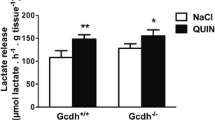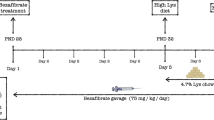Abstract
Glutaric acidemia type I (GA-I) is a neurometabolic disease caused by deficient activity of glutaryl-CoA dehydrogenase (GCDH) that results in accumulation of metabolites derived from lysine (Lys), hydroxylysine, and tryptophan catabolism. GA-I patients typically develop encephalopatic crises with striatal degeneration and progressive white matter defects. However, late onset patients as well as Gcdh−/− mice only suffer diffuse myelinopathy, suggesting that neuronal death and white matter defects are different pathophysiological events. To test this hypothesis, striatal myelin was studied in Gcdh−/− mice fed from 30 days of age during up to 60 days with a diet containing normal or moderately increased amounts of Lys (2.8%), which ensure sustained elevated levels of GA-I metabolites. Gcdh−/− mice fed with 2.8% Lys diet showed a significant decrease in striatal-myelinated areas and progressive vacuolation of white matter tracts, as compared with animals fed with normal diet. Myelin pathology increased with the time of exposure to high Lys diet and was also detected in 90-day old Gcdh−/− mice fed with normal diet, suggesting that dietary Lys accelerated the undergoing white matter damage. Gcdh−/− mice fed with 2.8% Lys diet also showed increased GRP78/BiP immunoreactivity in oligodendrocytes and neurons, denoting ER stress. However, the striatal and cortical neuronal density was unchanged with respect to normal diet. Thus, myelin damage seen in Gcdh−/− mice fed with 2.8% Lys seems to be mediated by a long-term increased levels of GA-I metabolites having deleterious effects in myelinating oligodendrocytes over neurons.





Similar content being viewed by others
References
Funk CB, Prasad AN, Frosk P, Sauer S, Kolker S, Greenberg CR, Del Bigio MR (2005) Neuropathological, biochemical and molecular findings in a glutaric acidemia type 1 cohort. Brain 128:711–722. https://doi.org/10.1093/brain/awh401
Goodman S, Frerman F (2001) In: Scriver CR, Beaudet AL, Sly WS, Valle D (eds) The metabolic and molecular basis of disease, 8th edn. McGraw-Hill Medical, New York, pp. 2195–2204
Kölker S, Ahlemeyer B, Krieglstein J, Hoffmann GF (2000) Evaluation of trigger factors of acute encephalopathy in glutaric aciduria type I: Fever and tumour necrosis factor-alpha. J Inherit Metab Dis 23(4):359–362. https://doi.org/10.1023/A:1005683314525
Strauss KA, Morton DH (2003) Type I glutaric aciduria, part 2: A model of acute striatal necrosis. Am J Med Genet C Semin Med Genet 121C:53–70. https://doi.org/10.1002/ajmg.c.20008
Hoffmann GF, Athanassopoulos S, Burlina AB, Duran M, de Klerk JB, Lehnert W, Leonard JV, Monavari AA et al (1996) Clinical course, early diagnosis, treatment, and prevention of disease in glutaryl-CoA dehydrogenase deficiency. Neuropediatrics 27:115–123. https://doi.org/10.1055/s-2007-973761
Zinnanti WJ, Lazovic J, Housman C, LaNoue K, O'Callaghan JP, Simpson I, Woontner M, Goodman SI et al (2007) Mechanism of age-dependent susceptibility and novel treatment strategy in glutaric acidemia type I. J Clin Invest 117(11):3258–3270. https://doi.org/10.1172/JCI31617
Gerstner B, Gratopp A, Marcinkowski M, Sifringer M, Obladen M, Bührer C (2005) Glutaric acid and its metabolites cause apoptosis in immature oligodendrocytes: A novel mechanism of white matter degeneration in glutaryl-CoA dehydrogenase deficiency. Pediatr Res 57:771–776. https://doi.org/10.1203/01.PDR.0000157727.21503.8D
Harting I, Neumaier-Probst E, Seitz A, Maier EM, Assmann B, Baric I, Troncoso M, Mühlhausen C et al (2009) Dynamic changes of striatal and extrastriatal abnormalities in glutaric aciduria type I. Brain 132:1764–1782. https://doi.org/10.1093/brain/awp112
Kulkens S, Harting I, Sauer S, Zschocke J, Hoffmann GF, Gruber S, Bodamer OA, Kölker S (2005) Late-onset neurologic disease in glutaryl-CoA dehydrogenase deficiency. Neurology 64:2142–2144. https://doi.org/10.1212/01.WNL.0000167428.12417.B2
Koeller DM, Woontner M, Crnic LS, Kleinschmidt-DeMasters B, Stephens J, Hunt EL, Goodman SI (2002) Biochemical, pathologic and behavioral analysis of a mouse model of glutaric acidemia type I. Hum Mol Genet 11:347–357. https://doi.org/10.1016/j.bbadis.2014.12.022
Koeller DM, Sauer S, Wajner M, de Mello CF, Goodman SI, Woontner M, Mühlhausen C, Okun JG et al (2004) Animal models for glutaryl-CoA dehydrogenase deficiency. J Inherit Metab Dis 27:813–818. https://doi.org/10.1023/B:BOLI.0000045763.52907.5e
Zinnanti WJ, Lazovic J, Wolpert EB, Antonetti DA, Smith MB, Connor JR, Woontner M, Goodman SI et al (2006) A diet-induced mouse model for glutaric aciduria type I. Brain 129(4):899–910. https://doi.org/10.1093/brain/awl009
Sauer SW, Opp S, Komatsuzaki S, Blank AE, Mittelbronn M, Burgard P, Koeller DM, Okun JG et al (2015) Multifactorial modulation of susceptibility to l-lysine in an animal model of glutaric aciduria type I. Biochim Biophys Acta 1852(5):768–777. https://doi.org/10.1016/j.bbadis.2014.12.022
Seminotti B, Amaral AU, da Rosa MS, Fernandes CG, Leipnitz G, Olivera-Bravo S, Barbeito L, Ribeiro CA et al (2013) Disruption of brain redox homeostasis in glutaryl-CoA dehydrogenase deficient mice treated with high dietary lysine supplementation. Mol Genet Metab 108(1):30–39. https://doi.org/10.1016/j.ymgme.2012.11.001
Goodman SI, Kohlhoff JG (1975) Glutaric aciduria: Inherited deficiency of glutaryl-CoA dehydrogenase activity. Biochem Med 13(2):138–140. https://doi.org/10.1016/0006-2944(75)90149-0
Strauss KA, Lazovic J, Wintermark M, Morton DH (2007) Multimodal imaging of striatal degeneration in Amish patients with glutaryl-CoA dehydrogenase deficiency. Brain 130:1905–1920. https://doi.org/10.1093/brain/awm058
Olivera-Bravo S, Isasi E, Fernandez A, Rosillo JC, Jimenez M, Casanova G, Sarlabos MN, Barbeito L (2014) White matter injury induced by perinatal exposure to glutaric acid. Neurotox Res 25:381–391. https://doi.org/10.1007/s12640-013-9445-9
Amaral AU, Seminotti B, Cecatto C, Fernandes CG, Busanello EN, Zanatta A, Kist LW, Bogo MR et al (2012) Reduction of Na+, K+-ATPase activity and expression in cerebral cortex of glutaryl-CoA dehydrogenase deficient mice: A possible mechanism for brain injury in glutaric aciduria type I. Mol Gene Metab 107:375–382. https://doi.org/10.1016/j.ymgme.2012.08.016
Paxinos G, Watson C (2007) The rat brain in stereotaxic coordinates. Academic Press, Sydney
Olivera-Bravo S, Isasi E, Fernández A, Casanova G, Rosillo JC, Barbeito L (2016) Astrocyte dysfunction in developmental neurometabolic diseases. Adv Exp Med Biol 949:227–243. https://doi.org/10.1007/978-3-319-40764-7_11
Jiménez-Riani M, Díaz-Amarilla P, Isasi E, Casanova G, Barbeito L, Olivera-Bravo S (2017) Ultrastructural features of aberrant glial cells isolated from the spinal cord of paralytic rats expressing the amyotrophic lateral sclerosis-linked SOD1G93A mutation. Cell Tissue Res 370(3):391–401. https://doi.org/10.1007/s00441-017-2681-1
Inoue K (2017) Cellular pathology of Pelizaeus-Merzbacher disease involving chaperones associated with endoplasmic reticulum stress. Front Mol Biosci 4:7. https://doi.org/10.3389/fmolb.2017.00007
Freeman OJ, Mallucci GR (2016) The UPR and synaptic dysfunction in neurodegeneration. Brain Res 1648:530–537. https://doi.org/10.1016/j.brainres.2016.03.029
Amaral AU, Cecatto C, Seminotti B, Ribeiro CA, Lagranha VL, Pereira CC, de Oliveira FH, de Souza DG et al (2015) Experimental evidence that bioenergetics disruption is not mainly involved in the brain injury of glutaryl-CoA dehydrogenase deficient mice submitted to lysine overload. Brain Res 16(1620):116–129. https://doi.org/10.1016/j.brainres.2015.05.013
Seminotti B, Ribeiro RT, Amaral AU, da Rosa MS, Pereira CC, Leipnitz G, Koeller DM, Goodman S et al (2014) Acute lysine overload provokes protein oxidative damage and reduction of antioxidant defenses in the brain of infant glutaryl-CoA dehydrogenase deficient mice: A role for oxidative stress in GA I neuropathology. J Neurol Sci 344(1–2):105–113. https://doi.org/10.1016/j.jns.2014.06.034
Baumann N, Pham-Dinh D (2001) Biology of oligodendrocyte and myelin in the mammalian central nervous system. Physiol Rev 81(2):871–927. https://doi.org/10.1152/physrev.2001.81.2.871RV
Rodrigues MD, Seminotti B, Amaral AU, Leipnitz G, Goodman SI, Woontner M, Gomes de Souza DO, Wajner M (2015) Experimental evidence that overexpression of NR2B glutamate receptor subunit is associated with brain vacuolation in adult glutaryl-CoA dehydrogenase deficient mice: A potential role for glutamatergic-induced excitotoxicity in GA I neuropathology. J Neurol Sci 359:133–140. https://doi.org/10.1016/j.jns.2015.10.043
Bergman I, Finegold D, Gartner JC Jr, Zitelli BJ, Claassen D, Scarano J, Roe CR, Stanley C et al (1989) Acute profound dystonia in infants with glutaric acidemia. Pediatrics 83:228–234
Soffer D, Amir N, Elpeleg O, Gomori J, Shalev R, Gottschalk-Sabag S (1992) Striatal degeneration and spongy myelinopathy in glutaric acidemia. J Neurol Sci 107:199–204. https://doi.org/10.1016/0022-510X(92)90289-W
Duncan DI, Radcliff AB (2016) Inherited and acquired disorders of myelin: The underling myelin pathology. Exp Neurol 283(Pt B):452–475. https://doi.org/10.1016/j.expneurol.2016.04.002
Harting I, Boy N, Heringer J, Seitz A, Bendszus M, Pouwels PJW, Kölker S (2015) 1H-MRS in glutaric aciduria type 1: Impact of biochemical phenotype and age on the cerebral accumulation of neurotoxic metabolites. J Inherit Metab Dis 38(5):829–838. https://doi.org/10.1007/s10545-015-9826-8
Sauer SW, Okun JG, Schwab MA, Crnic LR, Hoffmann GF, Goodman SI, Koeller DM, Kölker S (2005) Bioenergetics in glutaryl-coenzyme a dehydrogenase deficiency: A role for glutaryl-coenzyme a. J Biol Chem 280:21830–21836. https://doi.org/10.1074/jbc.M502845200
Lamp J, Keyser B, Koeller DM, Ullrich K, Braulke T, Mühlhausen C (2011) Glutaric aciduria type 1 metabolites impair the succinate transport from astrocytic to neuronal cells. J Biol Chem 286:17777–17784. https://doi.org/10.1074/jbc.M111.232744
Boggs JM, Rangaraj G, Heng YM, Liu Y, Harauz G (2011) Myelin basic protein binds microtubules to a membrane surface and to actin filaments in vitro: Effect of phosphorylation and deimination. Biochim Biophys Acta 808(3):761–773. https://doi.org/10.1016/j.bbamem.2010.12.016
Harauz G, Boggs JM (2013) Myelin management by the 18.5 and 21.5 kDa classic myelin basic protein isoforms. J Neurochem 125(3):334–361. https://doi.org/10.1111/jnc.12195
Baron W, de Jonge JC, de Vries H, Hoekstra D (2000) Perturbation of myelination by activation of distinct signaling pathways: An in vitro study in a myelinating culture derived from fetal rat brain. J Neurosci Res 59(1):74–85. https://doi.org/10.1002/(SICI)1097-4547(20000101)59:1<74::AID-JNR9>3.0.CO;2-P
Bhat RV, Axt KJ, Fosnaugh JS, Smith KJ, Johnson KA, Hill DE, Kinzler KW, Baraban JM (1996) Expression of the APC tumor suppressor protein in oligodendroglia. Glia 17(2):169–174. https://doi.org/10.1002/(SICI)1098-1136(199606)17:2<169::AID-GLIA8>3.0
Min Y, Kristiansen K, Boggs JM, Husted C, Zasadzinski JA, Israelachvili J (2009) Interaction forces and adhesion of supported myelin lipid bilayers modulated by myelin basic protein. Proc Natl Acad Sci U S A 106(9):3154–3159. https://doi.org/10.1073/pnas.0813110106
Kondo S, Murakami T, Tatsumi K, Ogata M, Kanemoto S, Otori K, Iseki K, Wanaka A et al (2005) OASIS, a CREB/ATF-family member, modulates UPR signalling in astrocytes. Nat Cell Biol 7:186–194. https://doi.org/10.1038/ncb1213
Mecha M, Torrao AS, Mestre L, Carrillo-Salinas FJ, Mechoulam R, Guaza C (2012) Cannabidiol protects oligodendrocyte progenitor cells from inflammation-induced apoptosis by attenuating endoplasmic reticulum stress. Cell Death Dis 3:e331. https://doi.org/10.1038/cddis.2012.71
Bahr O, Mader I, Zschocke J, Dichgans J, Schulz JB (2002) Adult onset glutaric aciduria type I presenting with a leukoencephalopathy. Neurology 59(11):1802–1804. https://doi.org/10.1212/01.WNL.0000036616.11962.3C
Kölker S, Mayatepek E, Hoffmann GF (2002) White matter disease in cerebral organic acid disorders: Clinical implications and suggested pathomechanisms. Neuropediatrics 33(5):225–231. https://doi.org/10.1055/s-2002-36741
Bradl M, Lassmann H (2010) Oligodendrocytes: Biology and pathology. Acta Neuropathol 119:37–53. https://doi.org/10.1007/s00401-009-0601-5
Acknowledgments
Grants from Conselho Nacional de Desenvolvimento Científico e Tecnológico (CNPq) - 470236/2012-4, Programa de Apoio a Núcleos de Excelência (PRONEX), Fundação de Amparo à Pesquisa do Estado do Rio Grande do Sul (FAPERGS) - 10/0031-1, Pró-Reitoria de Pesquisa/Universidade Federal do Rio Grande do Sul (PROPESQ/UFRGS) - PIBIT 18489, Financiadora de estudos e projetos (FINEP), Rede Instituto Brasileiro de Neurociência (IBN-Net) # 01.06.0842-00 and Instituto Nacional de Ciência e Tecnologia em Excitotoxicidade e Neuroproteção (INCT-EN) - 573677/2008-5.
The part of this work done in Uruguay was funded by IIBCE, PEDECIBA Biología. Eugenia Isasi was a fellow of the Uruguayan Agency for Innovation and Research (ANII).
Author information
Authors and Affiliations
Corresponding author
Ethics declarations
Conflict of Interest
The authors declare that they have no conflict of interest.
Electronic supplementary material
Fig. Suppl. 1
. Absence of significant effects of 2.8% Lys intake on neuronal population. NeuN positive cells in the striatum (a) and frontal cortex (b) of 90 days old animals submitted to 2.8% Lys without significant differences with those fed with ND shown in each respective inset. Calibration bars = 50 (a) and 60 (b) μm, respectively. (c) Density of cells positive to NeuN in the frontal cortex of WT and Gcdh−/− mice fed with ND and 2.8% Lys discarding significant loss of neurons in any condition. Data are the media ± SD of results from 3 independent experiments with 3–5 animals per condition. (GIF 94 kb)
Rights and permissions
About this article
Cite this article
Olivera-Bravo, S., Seminotti, B., Isasi, E. et al. Long Lasting High Lysine Diet Aggravates White Matter Injury in Glutaryl-CoA Dehydrogenase Deficient (Gcdh−/−) Mice. Mol Neurobiol 56, 648–657 (2019). https://doi.org/10.1007/s12035-018-1077-x
Received:
Accepted:
Published:
Issue Date:
DOI: https://doi.org/10.1007/s12035-018-1077-x




